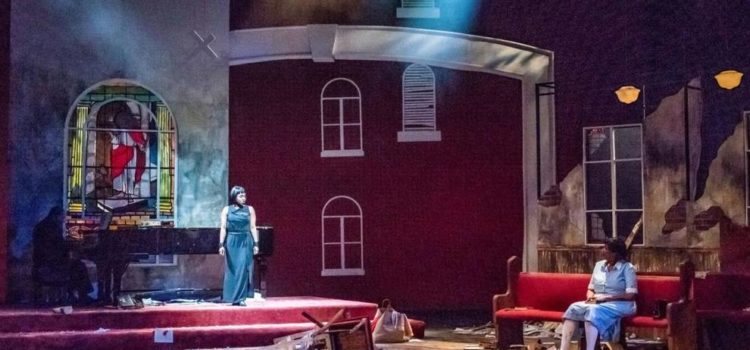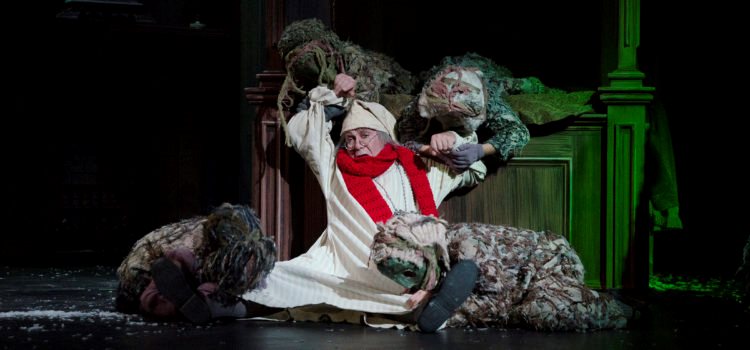By CB AdamsContributing Writer
During a weekend hyper-inflated with entertainments of mass
distraction – in particular, the Game of
Thrones series finale and the St. Louis Blues’ game of Stanley Cup – a
modest-sized audience was invited to engage with a deeper, more troubling, more
pressing and more prescient entertainment. Completing its 42nd
season, the Black Rep presented its production of Nina Simone: Four Women at the Edison Theatre on the Washington
University in St. Louis campus.
Set in the ruins of the 16th Street Baptist
Church in Birmingham after the 1963 bombing that killed four children, the play
earnestly, if unevenly, stands as a monument to the notion that everything old never
stops being new again. Playwright Christina Ham’s mash-up script attempts to
synthesize an array of social issues including, but not limited to, civil
rights, waning traditional religious values, the legacies and injustices of the
Old South and Jim Crow, adoption/abortion issues, culture and cultural
appropriation, white-on-black violence and intergenerational differences toward
sexuality and womanhood – all through the lens of Simone’s prickly personality
and her own artistic, personal and political frustrations.
Ham’s approach to this bomb-blast of issues is to sew its
many subjects into a large quilt rather than delve too deeply into any single patch
or two. In other words, a macro rather than micro approach. That’s a tall
order, especially when combined with a retrospective of Simone’s signature
songs and a presentation that’s equal parts concert, cabaret, revue and jukebox
musical, ala Mama Mia!. Ham’s conceit
seems to be: come for the Simone, stay for the social commentary.
At the heart of the play is one of Simone’s defining songs, “Mississippi Goddam.” And at the heart of that song are the lines, “Just try to do your very best / Stand up be counted with all the rest / For everybody knows about Mississippi goddam.”
This production, ably directed by Ron Himes, embodies that “do your very best” spirit while working through Ham’s something-for-everybody script. The four characters of the title are doing their best in their respective bad situations, each according to her experience, abilities and station in life.
The
four actresses playing those characters are the real strength of this
production. Maybe the conceit should be: come for the Simone, but definitely
stay for the performances of Leah Stewart as Simone, Denise Thimes as Sarah (aka
Auntie), Alex Jay as Sephronia and Camile “Cee” Sharp as Sweet Thing. Stewart
and Thimes make the most of their well-rounded characters. Sharp deserves extra
credit for her yeoman’s effort to animate the borderline one-dimensional
character of prostitute Sweet Thing. Scenic designer Tim Jones’s bombed-out
church set evocatively captures the devastation through which the characters
literally and metaphorically must move.
Impressive, too, and a testament to the strength of the St. Louis theater community, is that Stewart, Thimes and Jay are all natives of the Gateway City. Rounding out this exemplary local talent pool was a near-silent fifth character, the onstage piano accompanist, St. Louis native and musical director Charles Creath.
Cast of “Nina Simone: Four Women” Photo by Philip HamerThe script of Nina Simone: Four Women is too often clichéd (“walk a mile in my shoes”), too often expository in a biopic/Wikipedia sort of way (“It was my first top 10 hit”) and sometimes period-inappropriate (“skin in the game”). Yet, with the exception of a few flubbed lines, the actresses more than compensate for these shortcomings with their snappy timing, true heart and deep authenticity. And they soared and rose above the material individually and collectively performing “Old Jim Crow,” “Brown Baby” and “To Be Young Gifted and Black” and the other well-curated selections from Simone’s songbook.
The play seeks to make connections among the many issues it
touches and attempts to reach an epiphanic conclusion with the four characters
joining together for Simone’s song “Four Women.” The play’s wide-ranging reach
surpasses the ability of this one song to offer a satisfying resolution to the
issues it raises – but perhaps that point. It’s one woman’s (Simone herself) or
each character’s way of navigating a barrage of cultural adversities and finding
some meaning, strength and hope despite these challenges.
For this culmination, the attention instead should return to
“Mississippi Goddam.” Though the lyrics are relatively tame by modern urban
music’s standards, the anger is still palpable, real and relevant. It should
leave the audience realizing it’s not just Mississippi or Alabama goddam, but St.
Louis goddam and, yes, America goddam.
“Nina Simone: Four Women” plays at the Edison Theatre May 15-June 2. For tickets or more information, call the box office at 314-534-3807 or go online attheblackrep.org. A special $20 deal is available on Wednesday nights through the run.

Lynn (Zipfel) Venhaus has had a continuous byline in St. Louis metro region publications since 1978. She writes features and news for Belleville News-Democrat and contributes to St. Louis magazine and other publications.
She is a Rotten Tomatoes-approved film critic, currently reviews films for Webster-Kirkwood Times and KTRS Radio, covers entertainment for PopLifeSTL.com and co-hosts podcast PopLifeSTL.com…Presents.
She is a member of Critics Choice Association, where she serves on the women’s and marketing committees; Alliance of Women Film Journalists; and on the board of the St. Louis Film Critics Association. She is a founding and board member of the St. Louis Theater Circle.
She is retired from teaching journalism/media as an adjunct college instructor.




